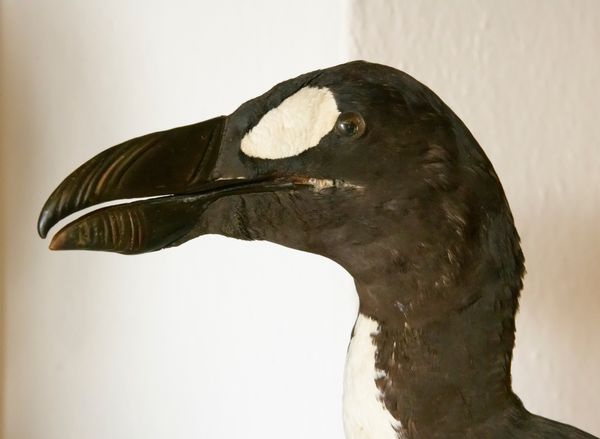LINKED PAPER
The Great Auk (Pinguinus impennis) had two brood patches, not one: confirmation and implications. Birkhead, T., Fiebig, J., Montgomerie, R. & Schulze-Hagen, K. 2021 IBIS. doi: 10.1111/ibi.13019 VIEW
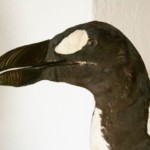
The avian brood patch may rank among the least charismatic or fascinating of organs. It warms the eggs and can be used to indicate the sex or breeding status of some species but, apart from that, it isn’t generally regarded as being very interesting. Pink and wrinkly, it is far from aesthetic. Yet, our discovery that the Great Auk had two brood patches, and not one, changes the way we think about the breeding biology of this iconic, extinct bird.
Like many previous researchers, I had assumed that the Great Auk had a single, central brood patch like its close relatives, the two guillemots or murres (Uria aalge and U. lomvia). Certainly, all the references I could find, including the earliest, from Martin Martin in 1698, state quite clearly that the Great Auk had only one brood patch. But the Great Auk’s closest relative, the Razorbill (Alca torda), has two, so I assumed that there had been an evolutionary transition from two to one brood patch in the Great Auk, as that species (like guillemots) incubated only a single egg and was thought to do so in a semi-upright posture.
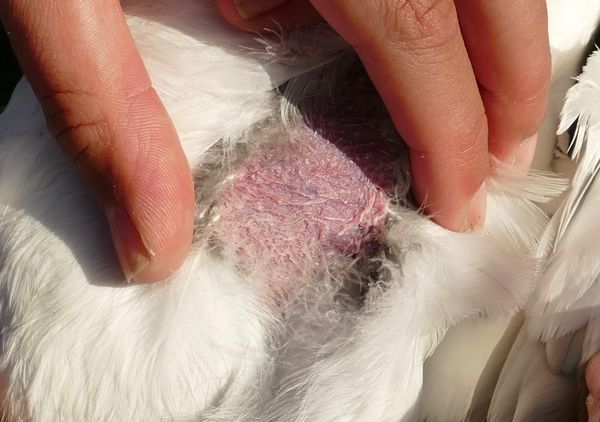
Figure 1 Pink and wrinkly: one of two brood patches possessed by the Razorbill © Richard Brown and Giselle Eagles.
The more I thought about it, though, it seemed odd that the Great Auk would be so unlike the Razorbill, and I wondered about examining some of the 70 or so mounted specimens that still exist. My colleague Karl Schulze-Hagen consulted Jüergen Fiebig, a museum curator in Berlin, who promptly examined the mounted Great Auk in their collection. ‘Two brood patches’, he told me—I was thrilled. Over the next few weeks, Jüergen visited other German museums and found the same: two brood patches. So, the Great Auk was like the Razorbill after all.
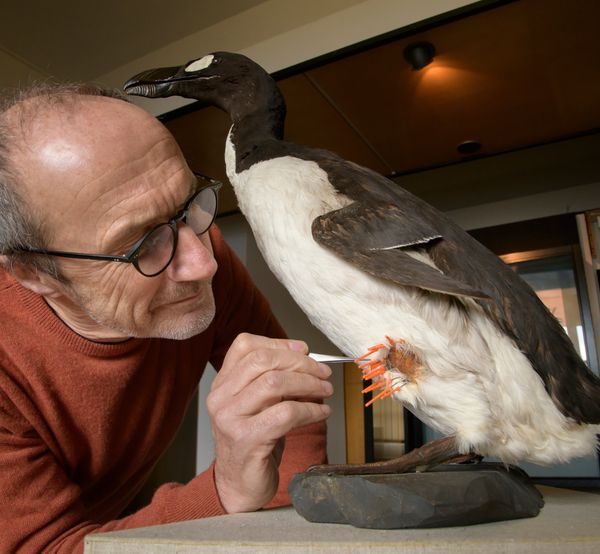
Figure 2 Jüergen Fiebig examining Naumann’s Great Auk specimen in the Naumann Museum with coloured pins indicating the position of one of its two lateral brood patches © Klaus Nigge.
How could those earlier writers—including Martin Martin, James Fisher and Ronald Lockley (authors of the 1954 New Naturalist Seabirds), and Sven-Axel Bengtson (1984 Auk 101: 1-12)—have been so wrong? By consulting with field workers we obtained good evidence for all extant 24 auk species and then mapped the number of brood patches and clutch size onto an up-to-date phylogeny of the Alcidae that included the Great Auk.
Martin visited St Kilda in 1697 and obtained information directly from the residents. His account of their way of life, and of the seabirds on whose lives they depended, is thought to be authoritative. But in fact, by the time of Martin’s visit, the Great Auk may already have been a scarce breeding bird there. He apparently never saw one, nor was he taken to where it was once thought to have bred.
What about Fisher and Lockley? They cite the very capable Danish ornithologist Frederik Faber (1826) as their source, and Bengtson in turn, cites Fisher and Lockley (1954). But Faber’s account — Ueber das Leben der hochnordischen Vögel — is difficult to read and understand. It now seems that they were wrong, for Faber’s account contains no explicit statement about the Great Auk’s brood patches. Indeed, Faber failed to see a Great Auk, either dead or alive, during his journey to Iceland in the 1820s.
The trade in Great Auk skins from Iceland was brisk in the early 1800s as the bird was hunted towards extinction. There would, therefore, have been ample opportunities for biologists to see their brood patches— almost all museum specimens are of birds killed during the breeding season. Yet, it seems that no biologist examined the dead birds, all of which were skinned by women in the tiny fishing community on Iceland’s remote Reykjanes Peninsula before being shipped to museums or dealers in Europe (Fuller 1999 The Great Auk).
Nonetheless, we discovered an account by the famous German ornithologist Johann Friedrich Naumann (1780-1857), a skilled taxidermist and co-author (with his father Johann Andreas) of one of the most important ornithological works of central Europe Naturgeschichte der Vögel Deutschlands (see the revised 1905 edition). In volume 12, Naumann states that the Great Auk has two brood patches. In all likelihood, Naumann made this discovery himself, for around 1830 he prepared a specimen, now known as ‘Naumann’s Great Auk’, from a skin he had received from Iceland (Fuller 1999).
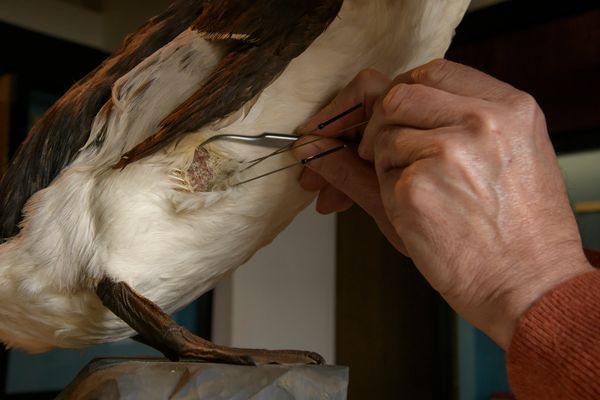
Figure 3 Jüergen Fiebig identifies one of the two lateral brood patches on the Naumann Great Auk specimen in the Naumann Museum, Koethen, Germany © Klaus Nigge.
History matters, especially in ornithology, where there is a rich literature stretching back into the 1600s. As this Great Auk example illustrates, old accounts often contain important observations and ideas. And there are also potential pitfalls in glibly quoting previous authors — like Martin, Fisher, Lockley, and Bengtson — and assuming that what they state is correct.
So why does it matter that the Great Auk had two brood patches?
First, it is consistent with evidence that the Great Auk’s closest relative was the Razorbill. Second, it demonstrates the value of museum collections. Third, it suggests the Great Auk incubated in a horizontal posture like the Razorbill, rather than semi-upright like the Uria guillemots. This in turn suggested to us that previous estimates of the Great Auk’s breeding density (and hence numbers at its colonies like Funk Island) needed revision. A bird incubating horizontally, would have occupied considerably more space than one incubating in an upright posture.
Guillemots (Uria spp.) incubate their single egg between their legs, pressed against their central brood patch. Razorbills lie down on the job, with their egg pressed against one or other of their two lateral brood patches. Seeing exactly how a Razorbill incubated was essential for understanding how a Great Auk may have done the same. With the Covid lockdown preventing me from easily visiting a Razorbill breeding colony, I asked colleagues Giselle Eagle and Rich Brown on Skokholm, and Julie Riordan on Skomer, to send me photographs and videos of incubating Razorbills — which they did. Those images helped answer a question that I am frequently asked: “If a bird like a Great Auk or Razorbill has only one egg, why does it need two brood patches?” The answer seems to be so that the incubating bird can face in either direction and still keep its egg on the safest side of its body. It seems likely that the Great Auk did the same.
References
Bengston, S-A. 1984. Breeding ecology and extinction of the great auk (Pinguinus impennis): anecdotal evidence and conjectures. Auk 101: 1-12. VIEW
Faber, F. 1826. Ueber das leben der hochnordischen vögel. E. Fleischer, Leipzig.
Fiser, J. & Lockley, R.M.1954. Sea-birds: an introduction to the natural history of the sea-birds of the North Atlantic. New Naturalist Series, Collins.
Fuller, E. 1999. The great auk. Southborough, Kent, England.
Martin, M.1698. A late voyage to St. Kilda, the remotest of all the Hebrides, or the Western isles of Scotland with a history of the island, natural moral, and topographical : wherein is an account of their customes region, fish, fowl, &c. : as also a relation of a late imposter there, pretended to be sent by St. John Baptist / by M. Martin, gent. Oxford Test Archive, Oxford.
Naumann, J.A. 1820. Naturgeschichte der Vögel Deutschlands. E. Fleischer, Leipzig.
Image credit
Top right: Naumann’s Great Auk in the Naumann Museum, Koethen, Germany © Klaus Nigge.
If you want to write about your research in #theBOUblog, then please see here.


